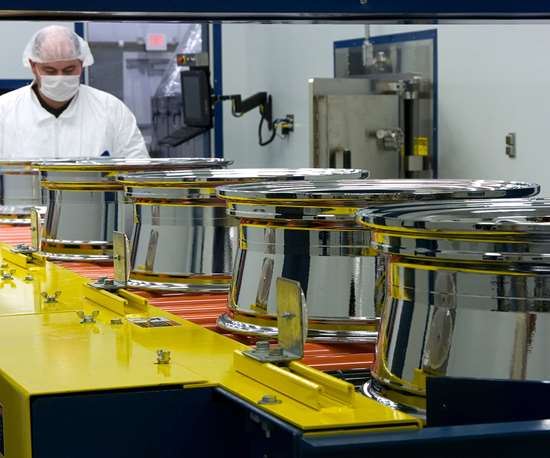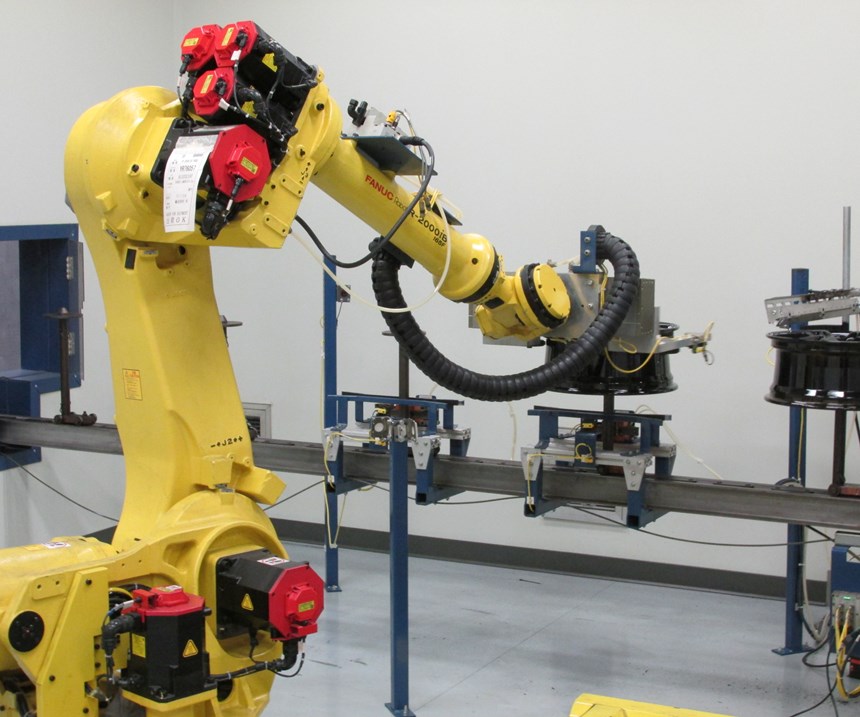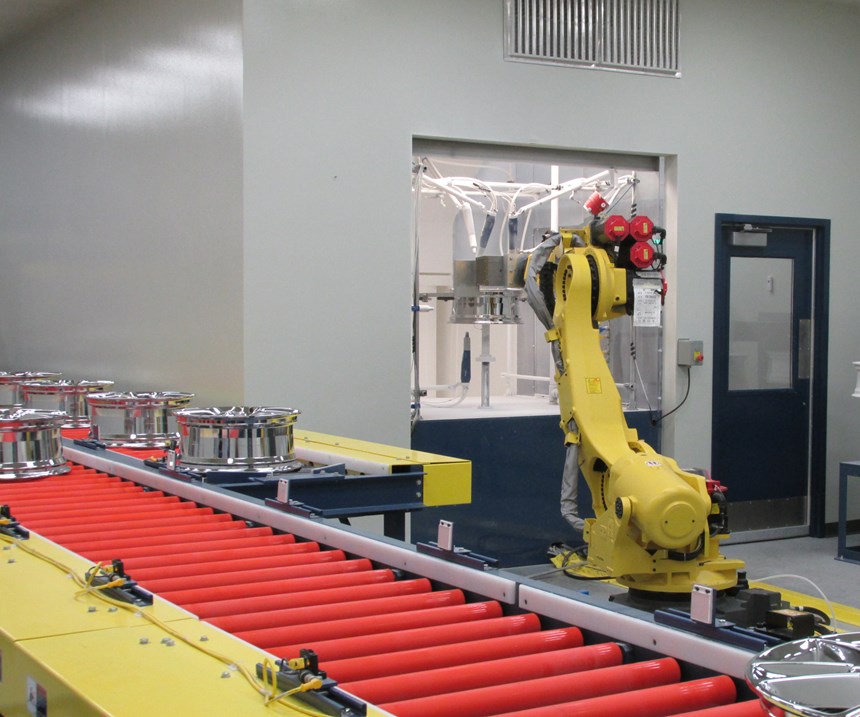Winona PVD Coatings takes quality so seriously that, out of almost 4 million wheels shipped in the past 10 years, the company can count the number of returns on both hands. The physical vapor deposition (PVD) coating provides the reliability of a painted wheel but the look of chrome and saves 1-2 pounds of weight on each wheel.
The company coats wheels with a bright finish for major OEM’s including with Nissan, Toyota, BMW and Karma. The company focuses on quality, continuous improvement and high-technology manufacturing—the wheels are not touched by human hands in the six hours it takes to produce them.
Featured Content
“Quality standards for the automotive industry are very demanding and only the best players can participate in that market,” says Tom Foley, president of Dynavac, a supplier for the company. “And Winona PVD can certainly do that.”
The company was founded in 2006 and is located near Winona Lake, in Warsaw, Indiana, a town known as the orthopedic capital of the world, a few hours outside of Detroit. The beauty of the Warsaw location is that they are centrally located to almost 90 percent of the car and truck manufacturing locations in the United States, as CEO Steve Bonnell points out. The Winona campus has two buildings with four production lines total, and recently completed an 83,000 square foot addition that features a chandelier made of a truck wheel.
“Quality and continuous improvement are part of our core values,” says Frank Browning, chief operating officer at Winona. “It is important that our team uses the right tool for the challenge.”
Browning recently graduated the latest class of supervisors, line managers and high potential team members from his Winona PVD Leadership Academy. The company is awash with quality initiatives, including Six Sigma, SPC, Design of Experiments, Ishikawa diagrams, the Five Whys and the 8Ds.
To prevent customer rejects, the company monitors potential defects closely, takes immediate corrective actions and looks for a definable root cause. The process involves cleanliness, checklists and standardization. To that end, the high-volume automated production lines are identical in how they look and run. Winona also has an agile manufacturing line dedicated to the custom aftermarket, commercial truck, RV and ATV orders in addition to validating new technologies and process improvements.
Big Order Drove Growth
“OEM companies do not just put a new company with a new technology in place without being confident of the results,” says Larry Beals, Winona’s executive vice president.
A major OEM gave them a small order with contingency plans in place. When Winona delivered 300,000 wheels with zero defects, they received a larger order, and and then a truck platform.
“Since then, we’ve not disappointed,” Beals says. The OEM even visited the company and said it was unusual for a small company to have such a large order.
Even at the best-run companies, quality issues do emerge. About a year ago, a few defective wheels came back from the field. Beals compares defects to a plane crash—multiple factors have to be in place in order for it to occur. To prevent future issues, they modified a lot of process parameters, looked into contamination and added more pass/fail conditions. All of this was done to keep its rejected parts per million in the single digits.
This attention to detail has helped the company grow from a startup to a Cinderella-success story. Though the PVD technology is not new, the company has been successful in refining the process, and they want to continue to grow globally and offer new technologies. Beals is black belt certified and the company has several other Six Sigma leaders, which is good for a small organization. Beals is currently working on the design and validation of the next generation vehicles with a Tier 1 customer.
Sputtering to Success
Bonnell joined the company a year ago and has worked to promote a culture of continuous improvement as part of the team’s DNA.
“Our employees are empowered to look for improvement in everything we do” he says. “Our business and customers benefit when our team gets professionally curious as to how things are done.”
Bonnell says a phrase is often repeated during the continuous improvements sessions: “Eliminate the difference between the way things are and the way they should be.”
The plant floor itself seems mainly inhabited by towering stacks of wheels. Throughout the floor, operators keep tabs on the process and inspect the wheels. Once a wheel is on the line, robots take charge. Wheels flow through the process without human contact—unless it has an issue in the inspection process, in which case an inspector has an opportunity to remove defects.
A display at each line shows how many parts were shipped in the last hour. There’s plenty of information to keep track of, and also to be proud of. In June, the company shipped its 4 millionth wheel.
The process looks simple, but there is a lot going on. It begins with raw castings which are prepared for painting. They are washed, pre-treated and prepped. This involves several steps: a base coat, a powder coating, a cure oven, then a dark blue powder for the next step in the process. The wheel goes through three curing ovens. The PVD process involves a vacuum, an alloy sprayed onto a wheel and finally a decompression chamber before the shiny wheel emerges.
Along the way, every wheel goes through a stringent inspection process. A defect of even half a millimeter would cause a reject. If there are any issues, the wheel is sent to a locked rejection cage so it doesn’t get intermixed with the good products. Three people inspect each wheel and then it is loaded onto the line.
Suppliers are a big part of the team. The company receives regular visits from vendors and suppliers, including top research scientists, constantly tweaking processes. Dynavac’s Foley has seen the company grow into the high-production powerhouse they are today.
“We’re in the middle of the process,” Foley says. “Our machine applies the PVD coating. Sputtering falls into that family of coatings.”
Foley says that the technology — known as magnetron sputtering — has been around for a long time and can be used for both decorative and functional coatings.
“The automotive industry probably has some of the highest quality standards that you’re going to find,” Foley says. “In mass production, you need to control many, many parts going into an automobile, the functional aspects of it and appearance.”
While other industries such as aerospace have high quality standards, the appearance of a part may not be as important. That is not so with a new BMW.
Predicting the future
Beals says Winona is set to transform the industry again having worked closely with suppliers to develop the first non-epoxy, acid resistant bright finish called Prestige PVD. Consumers gravitate toward acid-based cleaners known for polishing chrome wheels or removing brake dust.
“Listening to our global customers was the catalyst for providing enhanced durability in the field,” says Beals, who adds that Winona created a team and collaborating with key suppliers to engineer a solution that is impervious to acid-based wheel cleaners found on the retail shelf, at car washes and detailers that extends the look and performance of bright PVD wheels for years to come.
Some automotive OEMs are now adding acid cleaner exposure to their global specifications to incorporate this new Prestige PVD technology. Preferences vary across continents, with Europeans often preferring the black chrome style. The company offers three different Prestige PVD finishes: bright, black chrome and liquid silver.
This attention to detail has led to several new automotive OEMs adding PVD to their option list, and the future for Winona looks just as bright as their wheels.
Michelle Bangert is the managing editor of Quality magazine. Please visit qualitymag.com.
RELATED CONTENT
-
Why Vacuum Coating?
There is common interest among platers and vacuum coaters.
-
Vacuum Deposition Processes
The deposition of a film or coating in a vacuum (or low-pressure plasma) environment. Generally, the term is applied to processes that deposit atoms or molecules one at a time, such as in physical vapor deposition (PVD) or low-pressure chemical vapor deposition (LPCVD) processes.
-
An Overview of Hard Chromium Plating Using Trivalent Chromium Solutions
For more than forty years, academic and industrial researchers from all over the world have taken a strong interest in alternative processes for hard chromium plating using hexavalent ions. The benefits of substitute processes are obvious, as the toxic and carcinogenic aspects of hexavalent chromium are well known.























